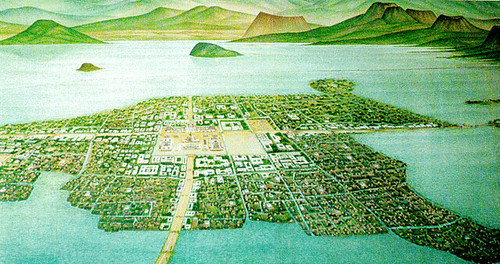Aztec Empire Strategy: Use Dual Pipes in Your Aqueduct for High Availability
With the Chapultepec aqueduct, also named the great aqueduct, the Aztecs built a novel uninterruptible water supply for providing fresh water to Tenochtitlan, their fast growing jewel of a capital city. A section of the aqueduct is still around today:

It's fun to think about how even 600 years ago how it was built with high availability in mind. We find engineers being engineers, no matter the age:
It consisted of a twin pipe distribution system made in part of compacted soil and in part of wood for the crossings of the aqueduct over the bridges built to allow the passage of the canoes. It was finished around 1466 AD, and the main purpose was to supply fresh water to Mexico-Tenochtitlan, to mitigate its thirst.
The main source for the aqueduct was the spring of Chapultepec and the purpose of the twin pipes was to ease the maintenance of the system, because the water was conveyed through one pipe, and when it got dirty, the water was diverted to the other pipe while the dirty pipe was cleaned and, if necessary, repaired (Palerm, 1973).
I love the attention to detail and vision evident in the design. Redundancy is still a key high availability strategy today and that link with engineers of the past is somehow comforting.
Clearly they valued 100% uptime for their water supply and felt strongly enough about that requirement to double the effort and material and build in redundancy from the start. I wonder if they ever felt pressure to run both pipes with water to double the supply? This would support more people, but could lead to significant service disruption due to maintenance windows. Would that cause hardship? Would it cause political unrest? Would an "email" go out saying expect degraded service for the next few days so fill up now? Could they fail over to secondary water sources during upgrades? What happened if the spring produced less water than expected? Culturally we are infinitudes apart, but when it gets to the creation of things in the physical worlds we inevitably follow the same rules and same intuitions. The more things change the more they stay the same.
One reason their water supply was so important was because of a design requirement I did not mention, the city is located in the middle of lake Texcoco!

Tenochtitlan and Venice - Separated at Birth
Tenochtitlan and Venice were built similarly. Millions of wood stakes were driven into the lake bed and the land built on top. In fact, there a lot of interesting parallels between the Aztecs and Venetians. Both the Aztecs and Venetians escaped enemies by running to water. Both figured out how to use wooden pilings to create a new land base. Both built impossibly huge monuments on their newly created land. Both created great empires that peaked at roughly the same period of time. And both eventually fell to invaders. While not exact, the parallels are at least close enough for a History Channel special.
High Availability is Not Disaster Recovery
Unfortunately for the Aztecs they didn't also disaster proof the design. Cortez followed a blockade strategy by seizing the aqueduct, stopping the flow of food and water into the city, thus softening up the Aztecs for attack, and eventual defeat.
Unique Circumstances Lead to Agriculture Innovations
Unique challenges drive innovation. It's when you are pushed to support 500 million users that you have to build the new things that push the art forward. Other than living on a small rock in the middle of a nearly infinite universe, what could be more challenging than living in the middle of lake?
The Aztecs figured out how to make land and bring in water, but what about food? You can't build an empire without food. And when you have a lake as a resource you figure out how to use it to your advantage.
The Aztecs did just that with the invention of a new highly productive agricultural process called chinampa, which is the process of creating "floating gardens" in the lake and growing crops on those floating gardens.

Lake Texcoco is not created by vast flowing rivers, it is a spring fed lake, which means it is both large and shallow. They figured out they could build small rectangle-shaped areas from reeds and grasses that would float on the water. Then they could scoop up dirt from the shallow lake bed to put on these floating garden plots.
The crops loved it. You can imagine the fertile lake bed soil, the hot sun, and the water from the lake wicking up through the bottom of the beds to water the plants, was highly productive. And it was. They were able to turn 6-7 crops through a year instead of just one. That vastly increased their production of food, which supported a larger population, which allowed them to conquer many thousand of square miles of land and build and Empire.
How cool is that?
Related Articles
- The remarkable hydrological works of the Aztec civilization by JOSE A. RAYNAL-VILLASENOR
- Farming With Nature - Permaculture with Sepp Holzer



